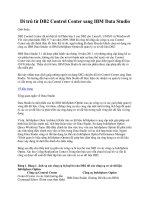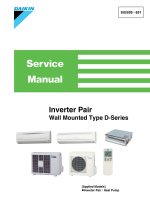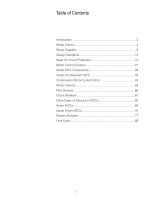SERVICE MANUAL FLEETWOOD - BATTERY CONTROL CENTER
Bạn đang xem bản rút gọn của tài liệu. Xem và tải ngay bản đầy đủ của tài liệu tại đây (170.64 KB, 12 trang )
<span class="text_page_counter">Trang 1</span><div class="page_container" data-page="1">
BCC P/N 00-00519-000
The Battery Control Center is a centralized power switching, fusing, and distribution center. Power from both the chassis and coach batteries is fed into the box. The full power of these batteries is available within this box. Inadvertent shorts inside this box could result in severe damage and/or injury.
Low current Test Light, Accurate Voltmeter (digital read-out preferred).
Slide plastic latch to the left while gently pulling outward.
Open Fuse Door. Then remove the four retaining screws that hold the cover in place. The cover will come off to expose the breakers and remaining wiring.
<i><b>All servicing within this box should be done only by a qualified Service Technician.</b></i>
Tools Required:
To Open Fuse Access Door:
To Gain Access to Circuit Breakers:
</div><span class="text_page_counter">Trang 2</span><div class="page_container" data-page="2"><b>BATTERY DISCONNECT</b>
The Battery Disconnect relays are used to disconnect the batteries during periods of storage or during service. The disconnect relays operate by momentarily applying 12 volts to the solenoid coil in either of two directions, (+12 volts on the “S” terminal and ground on the “I” terminal for opening and +12 volts on the “I” terminal and ground on the “S” terminal for engaging the relay).
The actuation voltage is supplied from the coach battery through F19. It is supplied to the momentary switches mounted in the coach and then fed back to the relays in the control center. (See Battery Disconnect schematic, Figure 1).
Both disconnect relays fail to operate.
One disconnect relay fails to operate.
Chassis relay fails to operate.
Coach functions operate when coach is plugged in, but not from battery.
Coach battery may be dead. Check for voltage at the top end of F9, the feed from the coach battery. F9 is located at the top, center of the printed circuit board. This voltage should be at least 11 volts. If it is less, charge the coach battery. If it is more than 11 volts, go on.
F9 may be blown. Using a test light, check for voltage at both ends of F9. This voltage should be at both ends of F9. If not, replace fuse F9.
Ground lead to switches may be open. Check for ground and 12 volts on “I” and “S” terminals of the Disconnect Relay while pressing the switch in the coach.
Wiring or switch faulty. To check the operation, have an assistant operate the switch inside the coach while checking for voltage on the “I” terminal of the relay and ground on the “S” terminal.
Disconnect Relay faulty. If at least 11 volts is available on “I” or “S” terminals, and relay fails to operate, replace relay. Ignition may be on. Check to be sure that the switched-ignition voltage is 0 volts.
Interlock relay, K3, faulty. Check for 12 volt power feeding switch, at connector G, pin 2.
No 12 volt power to switch. If there is no 12 volts, check fuse F9.
<b>Possible</b>
</div><span class="text_page_counter">Trang 3</span><div class="page_container" data-page="3"><i><b>FIGURE 1</b></i>
</div><span class="text_page_counter">Trang 4</span><div class="page_container" data-page="4"><b>CHARGING CIRCUIT</b>
The charging circuit will charge both batteries if either battery is being charged. It operates by sensing the voltage on the Main and Auxiliary batteries. If either voltage goes above 13.3 volts for more than 14 seconds, the isolator solenoid will pull in, charging both batteries. If , while the ignition is on, the voltage falls below 12 volts for more than 4 seconds, the isolator relay will open, keeping all of the alternator's output available for the chassis functions. If the ignition is off and the auxiliary battery voltage should drop below 12.8 volts for 4 seconds, the isolator relay will open, preventing the coach loads from discharging the main battery.
To prevent overcharging when connected to shore power for long periods of time, the system monitors the battery voltage and when it exceeds 13.8 volts for one hour, the chassis battery will be disconnected. When the voltage on that battery drops below 12.6 volts, the isolator will reconnect to recharge the battery.(See Charging Circuit/Aux Start schematic, Figure 2).
Coach battery does not charge
Chassis battery continues to drain.
The isolator relay is not closing. Check for voltage on coil terminals of isolator relay (should be approximately 4 volts). Operate the engine at a high idle for at least 20 seconds and check the chassis battery voltage. It must be at least 13.3 volts. If it less, check alternator.
If no voltage on coil, replace printed circuit board.
If there is voltage on coil (should be approximately 4 volts), check for voltage on both main terminals of relay. If different, replace relay.
Isolator relay not opening. Replace relay.
<b>Possible</b>
</div><span class="text_page_counter">Trang 5</span><div class="page_container" data-page="5"><b>IGNITION RELAY</b>
The ignition relay, K1, turns power on with the ignition switch to feed the ignition signal, rear heater, and leveling jacks controller. Failure of this relay will prevent the operation of these functions. The power for the coil of this relay comes from
<i>the ignition switch through Connector D, pin 3. (See Charging Circuit/Aux Start schematic, Figure 2)</i>
The rear heater, leveling jacks,
and/or the refrigerator fail to operate. Ignition relay fails to operate. Check for 12 volt power at terminals of ignition relay, at relay.
Check for 12 volt power coming into printed board on Connector D, pin 3. If no power here, check for faulty wiring from ignition switch.
Replace printed circuit board.
<b>AUXILIARY START</b>
The Auxiliary Start function is used to provide a “jump start” from the coach battery, in the event that the chassis battery does not have sufficient amount of charge to start the engine. It operates by momentarily connecting the chassis and coach batteries together through the isolator relay. This is accomplished by pressing the dash mounted switch which
<i>applies 12 volts to the isolator relay coil. This power is supplied to the switch by fuse F10. (See Charging Circuit/Aux Start</i>
<i>schematic, Figure 2)</i>
Auxiliary Start fails to operate. Fuse 10 blown. Check F10.
Coach battery dead. Charge battery. Isolator relay defective. Replace relay.
<b>Possible</b>
</div><span class="text_page_counter">Trang 6</span><div class="page_container" data-page="6"><i><b>FIGURE 2</b></i>
</div><span class="text_page_counter">Trang 7</span><div class="page_container" data-page="7"><b>SOLAR CHARGER</b>
The Solar Charger is used to control the output of roof-top mounted solar panels. These 50 watt panels can put out up to 21 volts and as much as 3.5 Amps of current. When the batteries are below 13 volts and there is output from the panels, the controller will operate in the full charge mode, applying the full output of the panels to the batteries, through a relay mounted on the printed circuit board. When the voltage on the batteries reaches 14.4 volts, the controller switches into a current limited, constant voltage mode. In this mode, the battery voltage is maintained at 13.6 volts at a maximum of 1 Amp. In either of the first two modes, the “CHARGING” LED on the monitor panel will be lit.
When the current falls below 0.25 Amps, the “CHARGING” LED goes out and the “CHARGED” LED will come on. If the voltage falls below 13 volts, the controller will switch back into the full charge mode.
The voltage thresholds are temperature compensated to assure proper charge on the batteries. (See Solar Charging Schematic, Figure 3)
CHARGING LED does not come on.
CHARGED LED does not come on.
Batteries not charging.
Solar panel not putting out sufficient power. Check for sun light on panel.
Check voltage coming from panel on CNE1. If low check panel wiring.
Replace Printed board.
More than 0.25 Amp drain on batteries. Turn off Battery Disconnect Relays.
Check voltage from solar panel when in sun light. Should be more than 15 volts. If less, check solar panel for damage.
Check wiring from panel. Relay K4 on board should be closed. If not replace board.
Check for excessive drain on batteries. Turn off Battery Disconnect relays to see if charging occurs.
<b>Possible</b>
</div><span class="text_page_counter">Trang 8</span><div class="page_container" data-page="8"><i><b>FIGURE 3</b></i>
</div><span class="text_page_counter">Trang 9</span><div class="page_container" data-page="9">The fuses used on this board are standard, plastic “ATO”, blade (automotive) type.
There are 20 positions for fuses on the board (See Figure 4). These are fed from four main sources, Disconnect-Switched Coach Battery, Coach Battery, Disconnect-Disconnect-Switched Chassis Battery, and Ignition Disconnect-Switched Chassis Battery. The 20 fuses and their size are as listed:
LP / CO Det. F1 10 Amp CNC4 Monitor Panel F2 10 Amp CNB2 Rear Radio F2 10 Amp CNB3 Luggage Lights F3 15 Amp CNB6 ACC Alarm F4 20 Amp CNC3 ACC Aux Switch F5 20 Amp CNC2
Main Memory Spare F6 3 Amp CND2 Solar Chrgr Main F7 15 Amp on board Solar Chrgr Aux F8 15 Amp on board Bat Disconnect Pwr F9 5 Amp J4 - 3 Aux Start Power F10 10 Amp CND5 Radio Power Aux F11 10 Amp CNC1
Monitor Panel F12 5 Amp CNA1 LP / CO Det. F13 10 Amp CNA4 Step Switch F14 5 Amp CNA6 Step power F15 25 Amp CNA8 ACC Main Sw F16 20 Amp CNA2 Utility Lts F17 15 Amp CNB5
Dash \Ign F18 10 Amp CNA7 Ignition Signal F19 5 Amp CNA3 Rear Heater F20 15 Amp can Disconnect-Switched Coach Battery Pin-Out
Coach Battery
Disconnect-Switched Chassis Battery
Ignition Switched Chassis Battery
</div><span class="text_page_counter">Trang 10</span><div class="page_container" data-page="10"><b>CIRCUIT BREAKERS</b>
There are two 50 Amp and one 30 Amp, type III (manual reset), circuit breakers mounted in the box. The two 50 Amp units are connected to the Coach battery through the Disconnect relay. These breakers are intended to connect to the converter and fuse panel within the coach. The 30 Amp unit is connected to the Main battery to feed the 12 volt power to refrigerator.
CNA - 8 pin in-line Mate-N-Lock Mating Housing AMP 640586-1
1 Monitor Panel Battery Main F12 2 ACC Main Switch (Spare, ) F16 CNB - 6 pin in-line Mate-N-Lock Mating Housing AMP 640585-1
1 Start Solenoid Power
2 Monitor Panel Bat A F2 3 Rear Radio Power F2 4 Start Solenoid Power
5 Utility Lts F17 6 Luggage Lts F3 CNC - 4 pin Mate-N-Lok Mating Housing AMP 1-480702-0
1 Radio Power Aux F11 2 ACC Aux Switch F5
4 LP /ÊÊCO Det. Aux. F1 CND - 5 pin Mate-N-Lok Mating Housing AMP 1-480763-0
1 Start Switch
2 Rear Radio Memory F6 3 Ignition Signal
4 Not Used
5 Aux Start Power F10
<b>Plugs - Pins & Functions</b>
Pin Function Fuse
Pin Function Fuse
Pin Function Fuse
Pin Function Fuse
</div><span class="text_page_counter">Trang 11</span><div class="page_container" data-page="11">CNE - 3 pin Mate-N-Lok Mating Housing AMP 1-480700-0
1 Solar Panel Power 2 Charged Indicator 3 Charging Indicator
CNF - 9 pin Mate-N-Lok Mating Housing AMP 1-480706-0
1 Chassis BD “I” terminal
1 Isolator relay coil
2 Chassis BD relay power F6 3 Coach BD Power 5
</div>








